 The New Normal?!?! Don’t Even.
The New Normal?!?! Don’t Even.
I am participating in a series of virtual challenges to try and get into some better habits. With Mount Fuji and Mount Everest already behind me, I set my sights on the pyramids of Giza.
At this point, most of my steps are still coming in one of two formats: walks around the neighbourhood and time on the elliptical staring out at what is currently a cold, snowy landscape. Visualizing warmth and sand seems like a great idea right about now. It’s getting a bit harder to stay focused. The elliptical is a much better workout, and my knees are getting stronger each week, but I miss walking. There’s something about covering actual ground that I’m missing.
My first medal arrived, celebrating the Mount Fuji challenge. It is, as I had hoped, absolutely gorgeous. I am starting to get a bit excited about hanging a rack of these in my office to celebrate getting back into motion. The next challenge (the Cabot Trail) is 298 km, so I suspect it will be a good long while before I earn my next medal.
On days when it gets up to warmer temperatures (-2° C or better), I’m heading out the door as soon as my last meeting concludes. There’s only a narrow window of opportunity before the sun sets, so I need to mobilize fast.
It’s a bit odd that now that the sun is starting to rise a little bit sooner, I am finding myself under-inspired. I’m grinding out the workouts with some grim determination, but the excitement I was feeling at the beginning of February faded as the weeks wore on and we finally had enough snow accumulation to make the sidewalks a messier proposition. By the beginning of March, I am now approaching a sort of grim fatalism. There’s something about watching March 16th approaching that is really throwing me off. Last year, Canada celebrated my birthday by closing its international border. What we all hoped would be a temporary situation has become “the new normal”, a phrase which is provoking an atavistic reaction in me.
I want my health back. I want to regain my mobility. I want to be able to move when these restrictions are finally lifted and I can get back to Africa, New Zealand, or Asia (perhaps all three). I long to be crawling through the bush, trying to get a picture of a leopard. I want to be able to paddle my canoe in to the right angle to see a malachite kingfisher. I want to fall asleep under the Milky Way, with the stars stretching from one side of the sky to another, with the sounds of hyaenas laughing punctuating the cool night air.
Heck, at this point, I’d like to be able to go out for dinner in an actual restaurant for the first time since the fall.
Staying inspired is hard work these days. Last weekend, I could not for the life of me choke out a blog post about anything. I had simultaneously too much to say and absolutely nothing new to say. I’m not the only one. Each day, I watch everyone around me struggling to do some really tough stuff. Parents are taking care of their kids, teaching classes, playing tech support, and trying to work online all at the same time. None of it ever stops or takes a break. Patients are managing their care remotely with only phone calls and e-mails from their doctors to help them navigate the system. People are trying to figure out how to pay the rent and feed their families now that they’ve lost their jobs. We’re all isolated from each other, and for many of us it is getting harder and harder to pick up the phone or turn on the camera in our devices to try and do yet another MS Teams meeting, WebEx meeting, Zoom meeting, blah, blah, blah.
We’re going to navigate through this patch with random music reference. Before you get to the postcard collection at the bottom, following my fictitious journey through the last 74.6 kilometres of my life, maybe now would be a good time to listen to The Bangles’ Walk Like an Egyptian and remember how utterly ridiculous the Eighties were. I remember black acid wash jeans, carefully ripped and worn, and with patches and safety pins. I remember long hair and a perm. Big hair. Really big hair. Oh, myyyy. Maybe I should stop reminiscing and leave you with something lighthearted and silly.
Walk Like an Egyptian
The Official Postcard Collection
Here are the postcards sent out by the app as I completed the mission. I have another five trees planted in my collection as well.
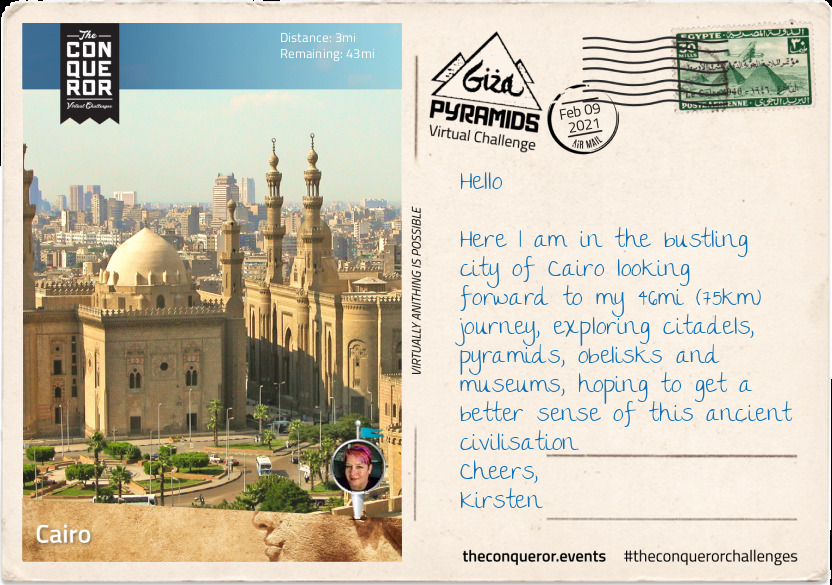
Step into history at the crossroads of Africa, Europe and Asia where an ancient civilisation developed and thrived on the banks of the Nile River. Filled with myths and legends, pharaohs and gods, formidable pyramids, mummies and hieroglyphs, this 5,000 year old civilisation is the kingdom of the ancient Egyptians.
The Kingdom of Egypt began around 3,100BC, known as the Early Dynastic Period, with the unification of Upper and Lower Egypt. Governed by a royal family the first Pharaoh was Narmer, also referred to as Nemes. Narmer was also the first dynasty (ruling family) out of 30 that followed.
Modern historians have further divided the dynasties into various Periods/Kingdoms. The three main Kingdoms, considered as the height of civilization (the golden ages) are known as: Old Kingdom (the Age of the Pyramids); Middle Kingdom (reunification of Egypt); and New Kingdom (the peak of power). As each Kingdom collapsed a period of civil unrest, conquests, political strife and instability ensued known as the Intermediate Periods. Each Intermediary Period ended when ruling houses reclaimed their power leading Egypt into a new age of prosperity. By 525BC the great civilisation came to an end and Egypt became part of the Persian Empire. Rule passed to the Greeks in 332BC following Alexander the Great’s conquest and by 30BC after the death of Cleopatra, the last reigning pharaoh, it became a province of the Roman Empire.
The ancient cities of Memphis and Thebes were once, at different times, the capital cities of Egypt. Memphis was created by Pharaoh Narmer and served as the capital city during the Early Dynastic and Old Kingdom eras. Following reunification during the Middle Kingdom, the capital city was moved to Thebes where it continued to serve as the capital during the New Kingdom era. Only remnants remain today.
The current capital city of Egypt is Cairo and has a population of 20 million people making it the largest city in Africa and the sixth-largest in the world. Within the city is “Historic Cairo” an area that existed before the city’s modern expansion. Declared a UNESCO site in 1979, Historic Cairo has a large collection of historic architecture including the Citadel where this journey begins.
Cairo was founded in the 10th century following the Fatimid Caliphate conquest. The Fatimid’s were a dynasty that occupied much of North Africa from the Red Sea to the Atlantic Ocean. Of Arab origin and ruling territories across the Mediterranean coast of Africa, the Fatimid’s made Egypt the centre of their caliphate.
The Fatimid’s were subsequently conquered by Saladin in the 12th century who was the first Sultan of Egypt. Saladin was a Sunni Kurd and the founder of the Ayyubid Dynasty, a Kurdish Sunni Muslim dynasty. He was a major force during the Crusaders of Jerusalem’s attempts to capture Egypt. Together with his uncle, the General at the time, Saladin seized Cairo and pushed the Crusaders out. Assuming control after his uncle’s death, Saladin began a major campaign against the Crusaders which resulted in the launching the Third Crusade by the powerful states of western Christianity. Led by Richard the Lionheart (King of England), King Phillip of France and Emperor Frederick Barbarossa (Holy Roman Emperor) the Battle of Arsuf against Saladin resulted in a truce followed by a peace treaty that lasted three years. Part of the treaty was safe passage to all Christian and Muslim unarmed pilgrims. Neither Saladin nor Richard were satisfied with the outcome. Both Richard and Saladin respected each other’s capabilities as leaders and were known to send each other gifts after the treaty. Saladin was widely regarded as a chivalrous warrior who besides being a shrewd and ruthless leader, he was also looked upon as a “kindly father figure who cared for the poor and sick”.
Saladin was primarily responsible for commencing the construction of the Citadel of Cairo in early 12th century which was built upon, altered and adapted across the centuries to suit the rulers needs and regimes of the time. It served as the residence of rulers and seat of Government until the 19th century. The complex was initially divided into two enclosures; one used for military garrisons and the other as the sultan’s residence. By the 19th century many of the buildings within the citadel were torn down to make way for an Ottoman-style mosque with two minarets, four small domes and four semi-circular domes around a main dome. It was commissioned by Muhammad Ali, the de facto ruler of Egypt at the time, in memory of his eldest son and constructed in the style that paid homage to his former overlords, the Ottomans.
Across from Muhammad Ali’s mosque is a 14th century mosque built by the then ruler, Sultan al-Nasir Muhammad. With a rather austere appearance when compared to its neighbour, the mosque is a rectangular building constructed around an inner court with two minarets and a single dome. The minarets with their bulbous shapes are made entirely out of carved stone and extensively decorated with glazed mosaics.
During the 20th century the citadel was first occupied by the British army, followed by the Egyptian military until the government opened it to the public converting buildings into museums. Today the citadel consists of several mosques (the two main ones and two smaller ones), a military museum, carriage museum, police museum and a palace containing a 1000kg chandelier gifted by Louis-Philippe I of France.
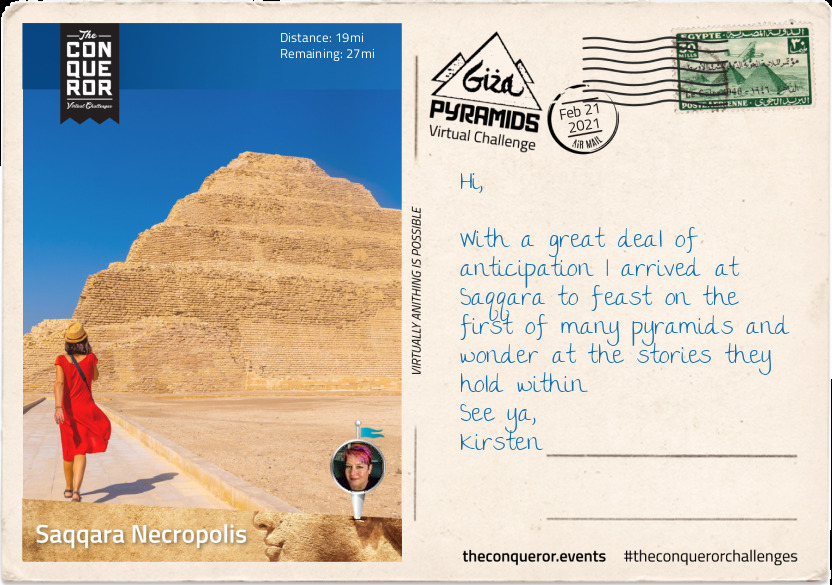
Sitting modestly before the vast Saqqara Necropolis is the Imhotep Museum, housing archaeological artifacts pertaining to the history of Ancient Egypt. Opened in 2006, it was named after the royal architect Imhotep, who was credited for building the first monumental structure out of stone, being the stepped Pyramid of Djoser.
The Saqqara Necropolis is a vast, ancient burial ground with many pyramids and mastabas within its boundaries. Mastabas were rectangular, flat-roofed tombs, made out of mudbricks. They were used by eminent Egyptians, such as Mereruka in the Early Dynastic Period and Old Kingdom. Mereruka was a vizier, a high ranking and powerful official, and son-in-law to King Teti, the 1st pharaoh of the sixth dynasty. The Mastaba of Mereruka is the largest of all non-royal tombs in Saqqara. Elaborately decorated with vibrant reliefs and a lifelike statue, the tomb was hidden from view until archaeologist Jacques de Morgan discovered and excavated it in 1892. The mastaba is also the burial ground for his wife (daughter of King Teti) and their son. The mastaba has a complex floorplan consisting of 33 chambers of which 21 are dedicated to Mereruka himself and the rest to his wife and son.
Beside Mereruka’s mastaba is the Pyramid of Teti. Once a smooth-sided pyramid, it now resembles more of a hill, largely due to poor preservation. However, the interior chambers and corridors are very well preserved. It is unknown how long Teti reigned but it is estimated at 12 years. Teti had several wives and up to 13 children (3 sons and 10 daughters). It is thought that he was murdered by his bodyguards in order to make way for Userkare’s reign. It is debated whether Userkare was possibly a son of Teti and whether he was a legitimate heir. Regardless of circumstances, his reign was short-lived, less than 5 years, when he was succeeded by Teti’s son Pepi I.
Teti’s predecessor was Unas, the last pharaoh of the 5th dynasty. His smooth-sided pyramid built in the 24th century BC was the smallest of the Old Kingdom. What made it significant though was the discovery of Pyramid Texts which were funerary texts carved into walls of burial chambers to help a pharaoh’s spirit to be preserved in the afterlife. Unas’ pyramid was the first inscription of such texts and at that time was reserved for pharaohs only. The Pyramid Texts were the predecessors to Coffin Texts when the spells were written on coffins and the Book of the Dead which were spells written on papyrus.
Egyptologists weren’t able to agree on Unas’ reign so it is guesstimated at between 15-30 years. It seems that Unas died without a male heir, as his only son predeceased him. As such it brought the end of the 5th Dynasty.
Diagonally across from the Pyramid of Unas is the Pyramid of Userkaf, the founder of the 5th Dynasty. He reigned for about seven years in the early 25th century BC. He had one daughter and one son, Sahure, who succeeded him. Little is known about his activities other than ascending the worship of Ra, deity of the sun. Ra was believed to rule the sky, the earth and the underworld. He was the god of the sun, order, kings and the sky. Pharaohs were closely aligned to Ra, referring to themselves as “Sons of Ra”. Pyramids, obelisks and sun temples were specially aligned to honour Ra.
Userkaf’s pyramid was very roughly put together. The core was built with small, roughly-hewn limestone blocks which likely saved a lot on labour but also produced an inferior quality pyramid. However, the outer layer was of fine limestone giving it a grand impression. Sadly as stone robbers removed the outer limestone, the loosely built core was exposed and crumbled leaving a pile of rubble in the shape of a hill. It was customary for pharaohs to build burials for their wives nearby and Userkaf had built a smaller pyramid to the southwest corner of his own using the same construction material and style. Unsurprisingly, the Queen’s pyramid is in rubbles too and her pyramid was stripped to such an extent that her burial chamber became exposed to the elements.
And this brings me to the final pyramid. Between the smaller pyramids of Unas and Userkaf stands the Pyramid of Djoser. It is a stepped pyramid built by the royal architect Imhotep and the oldest stone structure of its size in the world. Built in the 27th century BC, this six-tier, four-sided structure dominates the Saqqara landscape. The pyramid once covered in polished white limestone was originally 205ft (62.5m) tall with a base of 358x397ft (109x121m). Beneath the pyramid is a 6km labyrinth of tunnelled chambers and galleries that meets with a central shaft, providing the king with space for his and his family’s burials and the storage of goods and offerings. Once completed it stood out from the large mastabas that were constructed out of mudbricks.
Djoser’s pyramid is the only stepped-pyramid that was fully completed and continues to exist. A pyramid typically requires 20 years to complete. Djoser, one of the principal leaders of the 3rd Dynasty, ruled for between 19-28 years, as such he saw the completion of his pyramid. Djoser’s successor Sekhemkhet planned to outdo the building of his own pyramid by making it taller with a bigger base but unfortunately he died within 9 years of his reign and the pyramid remained unfinished. After Sekhemkhet’s there was one more stepped-pyramid just south of Giza but it is not confirmed whether it was finished or if it just eroded over time as it is a ruined structure now.
The Saqqara Necropolis has many more minor pyramids, mastabas and funerary complexes that are known of but there’s nothing more exciting than when new discoveries are made. A recent discovery (late 2020) of 100 intact wooden coffins, brightly covered with hieroglyphs and well-preserved mummies inside has been found in the Saqqara.
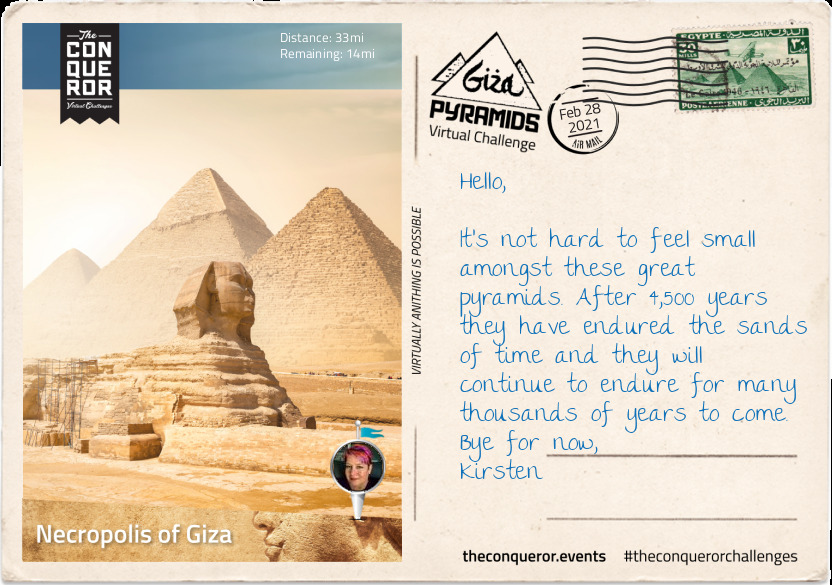 At the edge of the Western Desert, before the sprawling city of Giza stands the magnificent Necropolis of Giza. Within its boundaries the Necropolis is home to the Great Pyramids and their funerary temples, subsidiary pyramids, the Great Sphinx, mastabas and tombs. Built during the 4th Dynasty between circa 2575 and 2465 BC, the Necropolis’ most fascinating history sits with the three largest pyramids and its sphinx.
At the edge of the Western Desert, before the sprawling city of Giza stands the magnificent Necropolis of Giza. Within its boundaries the Necropolis is home to the Great Pyramids and their funerary temples, subsidiary pyramids, the Great Sphinx, mastabas and tombs. Built during the 4th Dynasty between circa 2575 and 2465 BC, the Necropolis’ most fascinating history sits with the three largest pyramids and its sphinx.
UNESCO listed in 1979, the pyramids are the final resting place for one family. Beginning with Pharaoh Khufu, his pyramid was known as the Great Pyramid because it was the tallest at 479ft (146m) with each side 754ft (230m) long. The Great Pyramid is also the only surviving architectural site on the Seven Ancient Wonders of the World list. It took 20 years to build and a total of 2.5 million blocks. Each block weighed an average of 2.5 tonnes. The pyramid was topped with a triangular capstone covered in gilt but it is no longer on it. To the east of his pyramid are three small subsidiary pyramids used as burial grounds for family members. To the south are two boat pits. One of them was excavated and within the pit was a jumble of 1224 pieces of wood. After several years it was pieced together into a 142ft (43m) long funerary boat. It remains on site inside a custom-built museum.
As usual it is debated how long he reigned. According to Manetho an ancient historian, Khufu reigned for 63 years, however, modern historians believe it to be more like 26-46 years. Not much is known about him, besides having two wives and several off-springs. He was succeeded by his son, Djedefre, who was then succeeded by his brother, Khafre, who built the second pyramid.
Khafre was considered a cruel and heretical ruler who wanted his pyramid to be bigger than his father’s. The pyramid is set in the middle of the three and although it seems taller because it was built on higher ground, the pyramid is actually 19.6ft (6m) shorter than Khufu’s. To the east of his pyramid is his funerary temple and linked via a causeway is the Great Sphinx. To the south is a subsidiary pyramid but not known as to who it belongs to. Khafre’s pyramid is the only one that still has the capstone on it.
The smallest pyramid belonged to Menkaure, the son of Khafre and grandson of Khufu. His pyramid stands at 213ft (65m) less than half the height of the other two. What is also noticeable is that the building materials used are different. Both Khufu and Khafre’s pyramids’ outer core was covered in expensive white limestone slabs. Menkaure’s pyramid had limestone on the top two-thirds, however, the bottom third which is still in place today, was covered in cheaper blocks of granite.
Menkaure was regarded as a kind and wise ruler. Disputes brought before him were fairly judged and he seemed to be much more considerate of his people by not having them work as hard on his pyramid as his predecessors. To the south of his pyramid are three small subsidiary pyramids possibly for his two wives and a daughter. He had two sons of which the eldest predeceased him leaving the younger son to succeed Menkaure. The younger son was the last pharaoh of the 4th Dynasty.
Interestingly at the end of the 12th century, Saladin’s son and heir who was Kurdish, attempted to demolish the pyramids in order to remove any signs of Egypt’s power. He started with Menkaure’s pyramid but after eight months with little progress – they were unable to remove more than one or two stones per day – he abandoned the effort, but not without leaving a large vertical gash on the northern face.
Standing guard on the east side of the Necropolis is the biggest statue in the world, the Great Sphinx. Measuring 240ft long x 66ft high x 62ft wide (73m x 20m x 19m), the sphinx has the body of a lion and the head of a human thought to be of Pharaoh Khafre. Carved from a small hill of solid limestone, the sphinx used to be painted red and yellow which has over time worn away. Drifting sand eventually buried the sphinx to its shoulders and although evidence suggests attempted restorations during the New Kingdom era by Pharaoh Thutmose IV it wasn’t until the early 19th century that the Sphinx was finally “dug out”. Archaeological studies also concluded that the sphinx’s nose was intentionally removed sometime between the 3rd and 10th centuries AD possibly a result of iconoclasm.
Somewhere between 2181-2040BC, Giza was abandoned and so was building pyramids. Low yields of crop in the 5th and 6th Dynasties cause widespread famine and a greatly reduced workforce. As such the Necropolis fell into decay, tomb robbers broke in and stole the buried treasures and many succeeding pharaohs during the Middle Kingdom broke up temples and walkways in order to reuse the materials on their own projects. By the New Kingdom (1570-1069BC) the reigning pharaohs reversed this approach and dedicated themselves to preserving the area.
Khaemweset, was the 4th son of Rameses II, and considered the “first Egyptologist”, due to his commitment to restoring and preserving Giza. His efforts are well documented.
At the turn of the 19th century and as part of his Egyptian campaign, Napoleon Bonaparte brought with him a team of experts to record their discoveries about Giza. But the most widely recognised archaeologist is Sir William Flinders Petrie due to his vast contribution to Egyptology. One of his greatest discoveries happened when a worker found a small headless statue with a pharaoh’s name at the bottom. Through careful digging, the head was found turning out to be the only known image of Khufu, builder of the Great Pyramid.
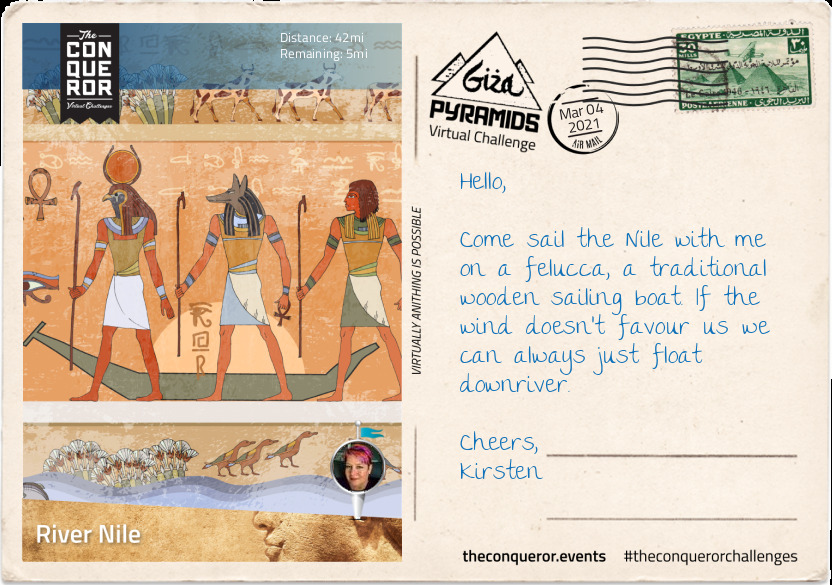
The Nile River is the longest river in the world, although some Brazilian scientists are currently claiming that the Amazon River is longer. It is 4,132mi (6,650km) long and travels through or on the border of ten African countries. It begins in the rivers that flow into Lake Victoria, north of Tanzania and flows northwards draining into the Mediterranean Sea. It has two tributaries: White Nile from Central Africa considered as the primary stream and the Blue Nile from Ethiopia considered as the main source of water up to 80% and silt. The two meet in Khartoum, Sudan becoming the Nile. The river is the main water source for both Egypt and Sudan.
The Nile was the lifeline of the Ancient Egyptians. The river flooded each year between June and September. This was due to the heavy summer rains and melted snow that was sent down the Ethiopian mountains into the Nile and overflowing the river banks. The Egyptians used to call this “akhet”, the inundation. The flood brought with it dark, fertile soil that was necessary for cultivating the farmlands with wheat, flax and papyrus. The dark soil deposit was called “kemet”, the black land and it was about 13mi (20km) wide. Either side of this was the “deshret”, the red land which was the desert area. The deshret provided protection from foreign conquerors and in the north where the land was swampy made it impossible for outsiders to cross.
Besides fertile soil, the Nile was also a source for water, transportation and travel. Boats and rafts were built to transport building materials such as stone for large scale projects like the pyramids. It is thought that funerary boats could have been used to carry deceased Pharaohs down the Nile to the afterlife or possibly used to carry them across the Nile to be mummified and buried.
The calendar of the Egyptians was created around the Nile’s yearly cycle. It had three seasons: inundation, growing season and harvest season. Great famine has occurred during times of drought, but none worse than during Djoser’s reign (Pharaoh of the stepped pyramid) when the Nile failed to flood the plains for seven years. The Famine Stela is an inscription carved into stone that tells the story of Djoser sending his vizier Imhotep to seek answers. Imhotep was visited by the god of fertility, Khnum, in his dreams who promised to make the Nile flow again. Imhotep recounts his dream to Djoser who in turn issues a decree to have Khnum’s temple restored and have regular offerings made to the god. Soon after the Nile began to flow once again.
The annual flooding was one of the most important events during Ancient Egypt, except for high-water years when whole crops were destroyed or drought years that caused famine. Today the flow of the Nile is controlled via a dam in Aswan where the reservoir can store the water for release during drier years. This protects the local farmers and the trademarked Egyptian Cotton crop that is grown on the Nile Delta. As Egyptologist Zahi Hawass once said “The Nile is the soul of Egypt”.
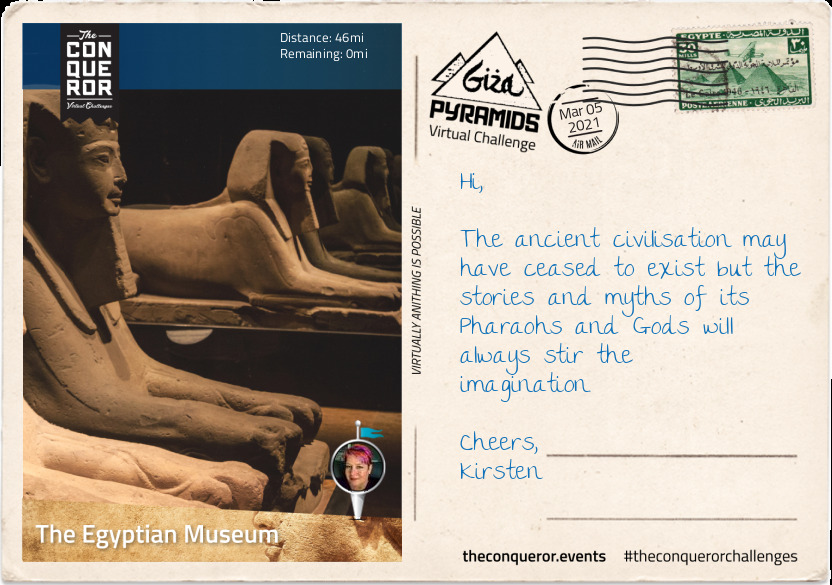
There were more than 175 pharaohs, 2,000 deities and over 100 pyramids during Ancient Egypt’s long history. Many tombs and pyramids have since been ransacked by thieves and for a long time there was no protection or preservation of Egyptian antiquities. Egyptian curiosity began with Napoleon Bonaparte’s campaign into Egypt between 1798-1801. Taking a group of scholars and scientists with him to learn all they could about Egypt, what followed was a series of publications distributed within France over a period of 20 years. All of the works, research, notes and illustrations were eventually compiled into the Imperial Edition consisting of 23 books entitled “Description de l’Égypte” (Describing of Egypt).
Prior to legislation many antiquities were removed from Egypt to join private collections or museums around the world. A decree was issued in 1835 by the then governor of Egypt, Mohamed Ali Pasha, prohibiting any export or trade of Egyptian antiquities.
The Egyptian Museum, where this journey ends, was born out of an international competition in 1895 and won by French Architect, Marcel Dourgnon. It houses 160,000 artifacts ranging from the pre-Dynasty period all the way through to the Roman era.
The Museum holds some very important pieces such as the Palette of Narmer which depicts the unification of Upper and Lower Egypt under one King. The palette is so significant that it has never been allowed to leave the country on any touring exhibitions.
Some of the earliest hieroglyphic inscriptions were found on the palette. Hieroglyphs were the formal writing system often used in tombs, monuments and religious texts. They were stylized pictures of objects representing a word, syllable or sound. For everyday purposes the writing style was hieratic script which was a faster version of hieroglyphs and then further simplified via demonic script to write legal documents. However, once they were conquered by Alexander the Great, scribes had to write in Greek and over time the meaning of the hieroglyphs was lost. No one understood it anymore until the Rosetta Stone was found in 1799. On the stone was a decree in two languages and three writing styles: hieroglyphic, demotic and Ancient Greek. Over the next 23 years scholars would build upon each other’s deciphering works until 1822 when French scholar Jean-Francois Champollion cracked the code. Ancient Greek was widely known by scholars and it was used as a way to work backwards till the code was finally deciphered.
Statues of the three kings who built the Giza pyramids are also within this museum’s collection. As big as the Great Pyramid is, Khufu’s statue is quite small all of 3in (7.5cm) but it is the only three dimensional image of him.
Walls are lined with coffins that once held mummified bodies. Mummification was a complex process that took 70 days to complete. Starting by removing the brain through the nose, then removing the organs which after they dried were stored in canopic jars. The heart was left inside as it was thought to be the seat of the soul. Interestingly it was believed the brain was useless and hence thrown away because they thought the heart was the centre of thought and personality. The body was rinsed, packed with natron (salt) then covered with more natron then left for several weeks to dehydrate the body. The next phase was to wash, oil and cover with resin as adhesive. Wrapping it completely in linen it was then placed in a mummy shaped coffin that was quite often intricately designed. Depending on status of the deceased, the mummy may have also been covered with a mask such as the one found on King Tutankhamun. Protective amulets were included in the coffin then sealed and the coffin was then inserted in a stone sarcophagus.
The most elaborate burial was that of King Tut. His mummy was inside several layers of container. There were three coffins each inside the other (like Babushka dolls) with the innermost coffin made entirely out of solid gold. The coffins lay inside a stone sarcophagus which rested inside four box-like shrines, each gilded and heavily decorated along with spells from the Book of the Dead inside.
Tutankhamun may have been only 19 when he died but he was instrumental in restoring the old gods which were banished by his father, Akhenanten, who only wanted to have one god for the royal court. All sorts of deities were worshipped by the Egyptians but the most powerful god was the sun god, Ra, who travelled across the sky in his sun-boat bringing warmth and light to the people.
One of the most influential stories in ancient Egyptian mythology was that of two brothers, Osiris (god of the underworld and afterlife) and Set (god of chaos). Osiris was once a Pharaoh and married to Isis (goddess of life and magic). Together they had a son Horus. Set wanted the throne and to rule Egypt. He tricked Osiris into climbing in a chest which Set then sealed shut and tossed down the Nile. Isis went searching for Osiris and when she found him he was already dead. She resurrected Osiris but he was neither dead nor alive, thereby forcing him to retreat to the underworld and become the king of the dead. Once Horus was fully grown, he set out to avenge his father and claim the throne. A battle ensued in which Horus lost his left eye but won the battle vanquishing Set. The eye became known as the “Eye of Horus” symbolising protection, royal power and good health.
Other famous pharaohs and queens who left their mark were:
- Hatshepsut – she ruled for 20 years supposedly on behalf of her stepson but eventually declared herself a Pharaoh and even started wearing a beard which was a sign of royalty. She was a great ruler re-establishing trade routes and maintaining an extended period of peace.
- Akhenaten – was the father of Tutankhamun, who abolished all the gods, closed all the temples and decreed only one sun-god, Aten.
- Nefertiti – was the wife of Akhenaten and a strong influence supporting monotheism. Her bust is widely recognised with her tall cap-crown and widely contested as to who owns it.
- Ramesses II – he reigned for 67 years and had 96 children. He built a huge number of monuments and temples that nearly bankrupted the throne and unabashedly declared himself a god.
- Cleopatra – she was the last active ruler of Egypt. Politically savvy she brought peace and prosperity to the people. When she heard that her lover, Marc Antony, was dead she took her own life. With her death the Egyptian empire came to an end.
Deep within its sands, both Saqqara and Giza Necropolis’ hold many more secrets yet to be uncovered. Ancient Egypt was an extraordinary civilisation. It was able to adapt to the conditions of the Nile river, build pyramids and other great works with great precision and had to invent many things for themselves like writing, mathematics, metallurgy, paper (the papyrus) and anything else they needed to function as a society. They laid the foundations to many things that were improved upon by later civilisations.

